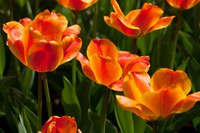Dakota Gardener: The biggest, boldest tulips
(Click an image below to view a high-resolution image that can be downloaded)
By Tom Kalb, Horticulturist
NDSU Extension
Nothing can match the beauty of tulips in spring. Their colors are absolutely brilliant!
Tulips are easy to grow their first year. They are almost foolproof.
Our biggest challenge is to keep our tulips blooming year after year. Many beds of tulips fade away after only a year or two.
That’s why I plant the biggest, boldest tulips available: the Darwin hybrids.
Darwin hybrids produce the biggest blooms on the sturdiest stems. These hybrids are extremely vigorous. With proper care, Darwin hybrids will bloom for many years longer than standard tulips.
There is an amazing palette of colors available, ranging from fiery shades of red and orange to soft tones of pink and apricot. The Apeldoorn and Impression series are very popular, but there are many Darwin hybrids available. Go to your garden center or shop online and explore!
Look for bulbs that are big and firm. The biggest bulbs will give you the most vigorous plants and reliable blooms.
The biggest tulip bulbs will be 12 or more centimeters in diameter. The 11/12-centimeter bulbs are fine. Avoid the small 10/11-centimeter size, because these bargain bulbs produce weak plants that likely will fade out after one year.
To maximize impact, plant six or more bulbs of each cultivar. Plant bulbs in clumps or drifts, not in rows.
Now is a great time to plant bulbs. We can delay planting until the ground freezes but earlier planting leads to greater root development this fall and healthier growth next spring.
Tulips demand a well-drained soil. I like mixing in an inch of organic matter (peat moss or compost) to the bed before planting.
Set Darwin hybrid bulbs about six to eight inches deep and about six inches apart.
After planting, sprinkle a bulb fertilizer containing timed-release nitrogen over the soil surface and work it in. A garden fertilizer such as 5–10–5 can be used as a substitute. Water the bulbs thoroughly to start them growing.
Mulch your tulip bed in November after the ground freezes. This mulch will stabilize the soil during winter, conserve moisture, and prevent bulbs from emerging too early in spring and getting damaged by frost.
It’s very important to maximize the life of your tulip beds. Clip the flower stalks when the blooms have withered. We don’t want the plant to waste any energy on producing seeds.
Instead, we want the plant to focus on refilling the bulb for the following spring. A light fertilization in spring can promote green leaves that nourish the bulb. Don’t remove these green leaves until they naturally turn yellow after refilling the bulb.
Let’s start making plans for a beautiful landscape next spring. It’s tulip time!
For more information about gardening, contact your local NDSU Extension agent. Find the Extension office for your county at https://www.ndsu.edu/agriculture/extension/county-extension-offices.
NDSU Agriculture Communication – Sept. 27, 2022
Source: Tom Kalb, 701-328-9722, tom.kalb@ndsu.edu
Editor: Kelli Anderson, 701-231-6136, kelli.c.anderson@ndsu.edu




